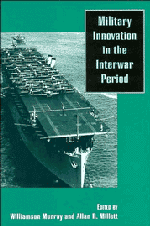Book contents
- Frontmatter
- Contents
- Acknowledgments
- Introduction
- 1 Armored warfare: The British, French, and German experiences
- 2 Assault from the sea: The development of amphibious warfare between the wars – the American, British, and Japanese experiences
- 3 Strategic bombing: The British, American, and German experiences
- 4 Close air support: The German, British, and American experiences, 1918–1941
- 5 Adopting the aircraft carrier: The British, American, and Japanese case studies
- 6 Innovation ignored: The submarine problem – Germany, Britain, and the United States, 1919–1939
- 7 From radio to radar: Interwar military adaptation to technological change in Germany, the United Kingdom, and the United States
- 8 Innovation: Past and future
- 9 Patterns of military innovation in the interwar period
- 10 Military innovation in peacetime
- Index
Introduction
Published online by Cambridge University Press: 05 August 2012
- Frontmatter
- Contents
- Acknowledgments
- Introduction
- 1 Armored warfare: The British, French, and German experiences
- 2 Assault from the sea: The development of amphibious warfare between the wars – the American, British, and Japanese experiences
- 3 Strategic bombing: The British, American, and German experiences
- 4 Close air support: The German, British, and American experiences, 1918–1941
- 5 Adopting the aircraft carrier: The British, American, and Japanese case studies
- 6 Innovation ignored: The submarine problem – Germany, Britain, and the United States, 1919–1939
- 7 From radio to radar: Interwar military adaptation to technological change in Germany, the United Kingdom, and the United States
- 8 Innovation: Past and future
- 9 Patterns of military innovation in the interwar period
- 10 Military innovation in peacetime
- Index
Summary
When the West began its ascent to world supremacy in the sixteenth century, military institutions played a crucial role in its drive to power. Recent historical work suggests that the Western military framework has undergone cyclical periods of innovation beginning in the early fourteenth century and continuing to the present and that such periods have resulted in systemic and massive changes to the basic nature of warfare and the organizations that fight. The military history of the twentieth century indicates that this pattern has continued unbroken except that the periods between major innovations have been decreasing even as the complexity of innovation has increased.
A number of factors have driven innovation in military affairs: the rapid pace of technological change, the vast sums spent on military research, and the increasing sophistication with which military organizations evaluate their performance and that of their weapons systems. The fusion of technology and potent management skills that mobilize mass organizations makes military change inevitable. If anything, the technologies influencing civilian life in the next century may have even greater impact on military force than has been true in this century.
The history of the years since 1939 has been one, for the most part, in which military organizations have had access to unparalleled levels of funding and resources. World War II was a great contest for world dominion, but the Cold War, which provided ideological fervor and motivation for vast defense budgets on both sides of competing alliance systems, followed almost immediately on the heels of the great conflict.
- Type
- Chapter
- Information
- Military Innovation in the Interwar Period , pp. 1 - 5Publisher: Cambridge University PressPrint publication year: 1996

